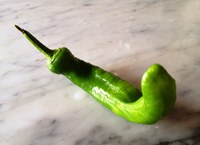Prairie Fare: Hot Peppers Heat Up a Winter Meal
(Click an image below to view a high-resolution image that can be downloaded)
By Julie Garden-Robinson, Food and Nutrition Specialist
NDSU Extension Service
“I can’t talk,” my husband said in a raspy voice that reminded me of the lead character in “The Godfather” movie.
Our daughters and I looked at him. I could see he was able to breathe, and I knew what the issue was.
We were at an authentic Mexican restaurant where they evidently had not “Americanized” the cuisine to incorporate milder peppers. Chile rellenos consist of a hot pepper stuffed with cheese and dipped in a batter and then deep-fried. I hadn’t had one in quite a long time.
“Mom, your nose is bright red,” our younger daughter noted.
I had just taken a bite of my chile relleno.
“These peppers are really hot. My mouth is on fire,” I said.
My eyes were watering and my sinuses were getting clearer by the second. I felt as though I had swallowed a cheese-coated, white-hot charcoal briquette that burned on its way down.
“Have some milk,” our 10-year-old said. I think she learned the trick from making salsa at home. She also saw us wearing plastic gloves when we worked with hot peppers.
Milk helped alleviate the burning caused by the peppers. An acidic food or beverage, such as sour cream or lemonade, also helps calm the burning sensation associated with hot peppers. Drinking water would spread the burning sensation, so I drank half of my daughter’s milk.
Our adventurous 15-year-old cut a piece of my chile relleno and popped it in her mouth as I watched. At first she had no reaction, then her face turned a deepening shade of pink. I think I detected steam coming out of her ears.
Our 10-year-old, not to be outdone by her older sister, snipped a tiny piece of the pepper from my plate with her fork and sniffed it.
“It smells weird,” she pronounced. She put it back.
I have to teach my kids to stop taking my food, I thought to myself.
Despite the reaction, my husband and I continued to eat the pain-inducing food.
When my husband recovered his voice a few minutes later, he cut open his pepper to reveal the seeds and veins still present. That’s where much of the capsaicinoids reside. These are the chemicals that impart the heat to hot peppers. You can reduce the heat in hot chilies by removing some of the veins and seeds.
According to some researchers, hot chili peppers speed up the metabolism and therefore cause our bodies to burn more calories than usual.
These hot little nuggets were “calorie bombs,” so we needed all the thermodynamic burn we could get or we would be wearing the calories permanently on our bodies.
Peppers are an excellent source of vitamins C and A. Among their many functions, vitamins C and A help us maintain a healthy immune system. Vitamin A keeps our skin, mucous membranes and eyes healthy, too.
Chili peppers have a long and interesting history that began in South America. Columbus gathered some pepper pods and noted their taste was similar to black pepper, so he called the pods “pepper” and brought them back to Spain. Their popularity soon spread.
Birds also played a role in the movement of wild pepper varieties from place to place. Birds do not detect the heat of a pepper, so when they ate them, flew away and consequently eliminated the seeds, wild chilies began to spread to other places.
According to the Chile Pepper Institute at New Mexico State University, 25 wild pepper species and five domesticated species of peppers exist. We are most familiar with the “annum” species that includes jalapeno, bell pepper, poblano and hundreds of other types.
Peppers can be classified as mild, medium or hot. The heat level varies based on the type of pepper and the growing conditions. The heat of peppers often is expressed in Scoville Heat Units, named after the American pharmacist who invented the scale. Taste testers sample various chili pepper samples, which are diluted in the lab until the heat no longer can be detected.
I guess my family won’t be qualifying as pepper taste-testers.
Although many people may think of the habenero pepper as the “hottest” pepper at 350,000 Scoville Units or greater, some types of peppers register in the 1 million to 2 million Scoville Units category. A bell pepper has no significant heat.
The “chile relleno” dish that inflamed our tongues at the restaurant often uses poblano, Anaheim or jalapeno peppers. A jalapeno pepper has a Scoville rating of about 10,000, while Anaheim and poblano peppers rate around 2,500.
Here’s an idea for quick and easy sandwiches from the University of Illinois Extension. Add a side salad, apple slices and low-fat or nonfat milk and you have a balanced meal. You can spice it up by using a mixture of bell peppers and hot peppers.
Sloppy Pepper Joes
1 pound extra-lean ground beef
1/2 c. chopped green bell pepper (or use a mixture of peppers)
1/2 c. chopped onion
1 Tbsp. vinegar
1/2 c. ketchup
2 Tbsp. prepared mustard
Combine ground beef, peppers and onion in skillet. Cook on medium heat until beef is browned. Add remaining ingredients, mixing well. Simmer 10 minutes. Serve on whole-wheat buns.
Makes seven servings (1/3 cup of meat mixture). Each serving has 180 calories, 11 grams (g) of fat, 13 g of protein, 6 g of carbohydrate, 1 g of fiber and 295 milligrams of sodium.
(Julie Garden-Robinson, Ph.D., R.D., L.R.D., is a North Dakota State University Extension Service food and nutrition specialist and professor in the Department of Health, Nutrition and Exercise Sciences.)
NDSU Agriculture Communication – Jan. 23, 2014
| Source: | Julie Garden-Robinson, (701) 231-7187, julie.garden-robinson@ndsu.edu |
|---|---|
| Editor: | Rich Mattern, (701) 231-6136, richard.mattern@ndsu.edu |



